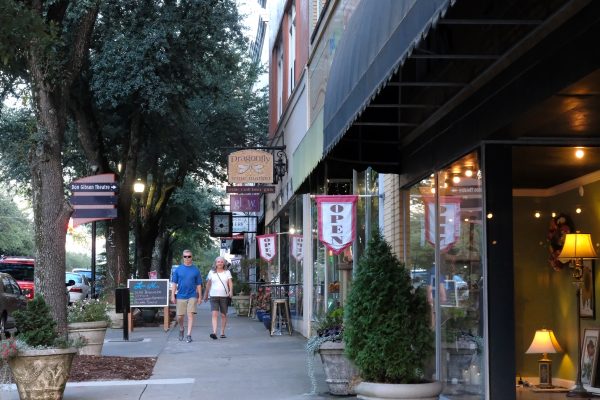Dynamic downtowns

Twenty years ago, the downtowns in our region were believed to be destined for oblivion. Retail was leaving, if not already gone, locating along a major thoroughfare somewhere on the suburban fringe in the vicinity of the latest big box retail store, often Wal-Mart. Professional offices, if any existed at all, were shutting their doors and moving away from downtowns. Residences were also scarce. A few of the retail establishments held on, some store fronts became locations for new churches, some buildings were boarded up. Most of our regional downtowns looked like ghost towns.
Today, if you were to visit the downtowns in Charlotte, Davidson, Mooresville, Belmont, York and many others you would have to conclude that the pessimism of twenty years ago has been replaced by a vigorous and exciting new energy in our center cities and towns.
Charlotte is a poster child for this rebirth . Twenty years ago, the streets rolled up when the office workers went home at 5:00, just like a suburban office park. The transition to a new day in Charlotte has been underway for ten or fifteen years. Even though the recession has had a negative impact on some aspects of the renaissance of downtown Charlotte, particularly in residential growth, the nightlife and cultural attractions have continued their dramatic growth throughout the last decade.
Does downtown Charlotte match Manhattan, San Francisco, Boston, or Chicago? Hardly. Is it more exciting than Greensboro, Raleigh, Richmond, or Columbia? You bet. If you haven’t experienced downtown Charlotte on a Thursday or Friday night for ten years, all I can say is go. You are likely to be amazed by the range of entertaining options you will find, and most importantly Charlotte is the preeminent people watching place between Washington and Atlanta. By the way, Charlotte’s downtown puts Atlanta’s downtown to shame. Handsdown.
What about other parts of the region? Charlotte is not the only place where rebirth has occurred. Regional downtowns, particularly ones that have historically had a distinct part of the town delineated either by geography or perception as “downtown,” are exhibiting the same dynamic, although on a smaller scale, than one sees in Charlotte.
I live in Davidson so I have daily exposure to North Mecklenburg and South Iredell towns. Davidson has a historic advantage. Its quaint downtown never declined and has continued to provide retail for its surrounding area for over 100 years; however, even Davidson is a much more dynamic place than it was ten years ago. Up until a few years ago, nothing much happened on weekends, unless there was some event associated with Davidson College. And then the timely idea to have a farmer’s market totally changed Saturday mornings in Davidson – the parking places are all taken, Summit Coffeehouse is full, restaurants do a brisk business at noon, and the sidewalks are full of people talking, window shopping, and lollygagging about.
Mooresville, a typical mill town a few years back, now features wine tastings, gallery crawls, an Art Guild that is currently hosting a major show by preeminent watercolorists from across the country , music on the lawn and in the Charles Mack Center , and a new bakery and restaurant. Does this sound like a mill village? I don’t think so.
Belmont and McAdenville have newly energized downtowns. Gastonia, which has struggled to give life to its downtown, is making strides. Mt. Holly is feverishly working to redevelop and develop its downtown area.
We have places like Waxhaw, Locust, Oakboro, Badin and York that have become known to others in the region primarily because of their revitalized downtowns. Meanwhile, some of our region’s county seats have been able to maintain fairly vigorous downtowns since their establishment— Statesville, Shelby, Lincolnton, Hickory, Salisbury, and Concord come to mind.
We also have examples of towns that developed without a clearly delineated downtown that are now trying to establish a vital and attractive center. This process presents a much greater challenge than the rebirth of a town that already has an area commonly identified as downtown. Many of these towns grew up along a thoroughfare with the functions commonly viewed as a part of a downtown spread linearly along the street without any noticeable concentration. Mint Hill, Locust, and Harrisburg are examples of such towns.
And we also have examples of newly built downtowns. Probably the best examples in the region are Birkdale, in northern Mecklenburg county, and Baxter, in northern York county.
The evidence is pretty clear. The suburban big box retail option dealt a blow to our regional downtowns, but it was not a fatal blow. In fact, our towns have weathered that storm and have come back by emphasizing niche markets, micro-retail, festivals and celebrations, cultural events, music, residential opportunities, and other community building dynamics. In observing the travails that the big box retail business has experienced during the current recession, the resurgence of our downtowns may well be the wave of the future.
We, at the Urban Institute, are all about celebrating the positive things that are happening in our downtowns; however, we need to tap in-depth local knowledge to be able to paint the full picture. We hope the readers of this website will offer their own perspectives on their town or neighboring towns and cities in the region. We need on-the-ground observations and insights to build our website into an increasingly rich and meaningful resource for our area.
Your input is appreciated. Contact us.